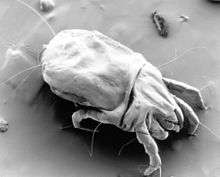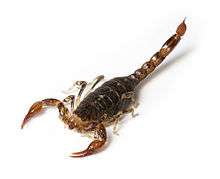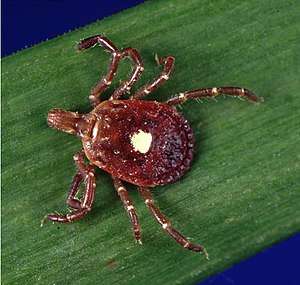House dust mite
House dust mites (HDM, or simply dust mites) are mites found in association with dust in dwellings.[1] They are known for causing an allergy.
.jpg)
The main species are:
- Dermatophagoides farinae (American house dust mite)
- Dermatophagoides microceras
- Dermatophagoides pteronyssinus (European house dust mite)
- Euroglyphus maynei (Mayne's house dust mite)
Biology
Taxonomy
The dust mites are cosmopolitan members of the mite family Pyroglyphidae.
Characteristics

House dust mites, due to their very small size and translucent bodies, are barely visible to the unaided eye.[2] A typical house dust mite measures 0.2–0.3 mm in length.[3] For accurate identification, one needs at least 10× magnification. The body of the house dust mite has a striated cuticle.
Diet
They feed on skin flakes from animals and humans, and on some mold. Dermatophagoides farinae fungal food choices in 16 tested species commonly found in homes was observed in vitro to be Alternaria alternata, Cladosporium sphaerospermum, and Wallemia sebi, and they disliked Penicillium chrysogenum, Aspergillus versicolor, and Stachybotrys chartarum.[4]
Predators
The predators of dust mites are other allergenic mites (Cheyletiella), silverfish and pseudoscorpions.[5]
Reproduction
The average life cycle for a house dust mite is 65–100 days.[6] A mated female house dust mite can live up to 70 days, laying 60 to 100 eggs in the last five weeks of her life. In a 10-week life span, a house dust mite will produce approximately 2,000 fecal particles and an even larger number of partially digested enzyme-covered dust particles.
Distribution
Dust mites are found worldwide, but are found more commonly in humid regions.[7] The species Blomia tropicalis is typically found only in tropical or subtropical regions.[8] Detectable dust mite allergen was found in the beds of about 84% of surveyed United States homes.[9] In Europe, detectable Der p 1 or Der f 1 allergen was found in 68% of surveyed homes.[10]
Health issues
Allergies
See: Dust Mite Allergy
Oral mite anaphylaxis
Dermatophagoides spp. can cause oral mite anaphylaxis (AKA pancake syndrome) when found in flour.[11][12]
Control techniques
House dust mites are present indoors wherever humans live. Positive tests for dust mite allergies are extremely common among people with asthma. Dust mites are microscopic arachnids whose primary food is dead human skin cells, but they do not live on living people. They and their feces and other allergens which they produce are major constituents of house dust, but because they are so heavy they are not suspended for long in the air. They are generally found on the floor and other surfaces until disturbed (by walking, for example). It could take somewhere between twenty minutes and two hours for dust mites to settle back down out of the air.
Dust mites are a nesting species that prefers a dark, warm, and humid climate. They flourish in mattresses, bedding, upholstered furniture, and carpets. Their feces include enzymes that are released upon contact with a moist surface, which can happen when a person inhales, and these enzymes can kill cells within the human body.[13] House dust mites did not become a problem until humans began to use textiles, such as western style blankets and clothing.[14]
Furniture
Furniture with wooden or leather surfaces reduces the dust mite population.[15]
Bed linen
Hot tumble drying a bed linen for 1 hour will kill 99% of mites therein.[17]
Weekly changing the bed linen reduces the risk of exposure to dust mites.[16]
Cotton covers not covered with complete mattress covers are very likely to become colonised by bacteria and molds; they must be cleaned periodically (at least every second to third month). Here, the dust mites are beneficial as they return cotton to its original state after it has degraded by contact with bare skin.[18]
Dust mite eggs are freeze tolerant (−70 °C for 30 minutes); hatching can normally be prevented by exposure of fabrics to:[19]
- Direct sunlight for 3 hours or
- Dry or wet heat of at least 60 °C (140 °F) for a minimum of 30 minutes.
Dust mites drown in water.[20]
Good properties of anti-mite fabrics have been identified as being:[21]
- Thread count greater than 246.
- Pore size of between 2 and 10 micrometres.
- Allergen impenetrability >99%.
- Dust leakage of less than 4%.
- Breathability between 2 and 6 cm3 s−1 cm−2.
Indoor climate
Allergy patients are advised to keep the relative humidity below 50%, if possible. Very few mites can survive if the humidity is less than 45% (at 22 °C (72 °F)). However, they can survive if the humidity is high just for an hour and a half per day, for example due to cooking.[20]
See also

References
- Denmark, H. A.; Cromroy, H. L. (April 2017) [October 1998]. "House dust mites—Dermatophagoides spp". Featured Creatures. Department of Entomology & Nemotology, University of Florida, and Florida Department of Agriculture and Consumer Services, Division of Plant Industry. EENY-59. Originally published as DPI Entomology Circular 314.
- "Why study the major cause of allergy, the house dust mite?". HouseDustMite.com. Retrieved 24 January 2019.
- "The House Dust Mite: Dermatophagoides pteronyssinus". MicrobiologyBytes. 2007. Archived from the original on 16 May 2007. Retrieved 24 January 2019.. Note that the video is gone.
- Naegele, Alexandre; Reboux, Gabriel; Scherer, Emeline; Roussel, Sandrine; Millon, Laurence (1 April 2013). "Fungal food choices of Dermatophagoides farinae affect indoor fungi selection and dispersal". International Journal of Environmental Health Research. 23 (2): 91–95. doi:10.1080/09603123.2012.699029. ISSN 0960-3123. PMID 22774849.
- "House dust mites: Agents of allergy". acari.be. Archived from the original on 29 December 2010. Retrieved 24 January 2019.
- Miller, J. D. (23 June 2018). "The Role of Dust Mites in Allergy". Clinic Rev Allerg Immunol: 1–18. doi:10.1007/s12016-018-8693-0. ISSN 1559-0267. PMID 29936683.
- Madden, Anne A.; Barberán, Albert; Bertone, Matthew A.; Menninger, Holly L.; Dunn, Robert R.; Fierer, Noah (2016). "The diversity of arthropods in homes across the United States as determined by environmental DNA analyses". Molecular Ecology. 25 (24): 6214–6224. doi:10.1111/mec.13900. ISSN 1365-294X. PMID 27801965. Lay summary.
- Dutra, Moisés S; Roncada, Cristian; da Silva, Guilherme L; Ferla, Noeli J; Pitrez, Paulo M (2018-05-04). "Mite Fauna Assessment in Houses of Two distinct Socioeconomic Groups From Southern Brazil". Journal of Medical Entomology. 55 (3): 620–625. doi:10.1093/jme/tjx239. ISSN 0022-2585. PMID 29281052.
- Arbes, Samuel J.; Cohn, Richard D.; Yin, Ming; Muilenberg, Michael L.; Burge, Harriet A.; Friedman, Warren; Zeldin, Darryl C. (2003-02-01). "House dust mite allergen in US beds: Results from the first national survey of lead and allergens in housing". Journal of Allergy and Clinical Immunology. 111 (2): 408–414. doi:10.1067/mai.2003.16. PMID 12589364.
- Luczynska, Christina; Svanes, Cecilie; Dahlman-Hoglund, Anna; Ponzio, Michela; Villani, Simona; Soon, Argo; Olivieri, Mario; Chinn, Susan; Sunyer, Jordi (2006-09-01). "Distribution and determinants of house dust mite allergens in Europe: The European Community Respiratory Health Survey II". Journal of Allergy and Clinical Immunology. 118 (3): 682–690. doi:10.1016/j.jaci.2006.04.060. ISSN 0091-6749. PMID 16950288.
- Barrera, OM; Murgas, IL; Bermúdez, S; Miranda, RJ (June 2015). "[Oral anaphylaxis by ingestion of mite contaminated food in Panama City, 2011-2014]". Revista Alergia Mexico. 62 (2): 112–7. PMID 25958374.
- Sánchez-Borges, Mario; Suárez-Chacon, Raúl; Capriles-Hulett, Arnaldo; Caballero-Fonseca, Fernan; Iraola, Victor; Fernández-Caldas, Enrique (1 January 2009). "Pancake Syndrome (Oral Mite Anaphylaxis)". World Allergy Organization Journal. 2 (5): 91–6. doi:10.1186/1939-4551-2-5-91. ISSN 1939-4551. PMC 3651046. PMID 23283016.
- Abadi, Sara (August 2009). "The Great American Hygiene Survey Results Revealed". AOL Health. Archived from the original on 2009-08-26. Retrieved 2018-10-10.
- Matthew J. Colloff, Dust Mites
- "Dust mite-proof pillow cover: MedlinePlus Medical Encyclopedia Image". MedlinePlus. 2019-03-07. Retrieved 2019-03-14.
- Carrard, A; Pichler, C (April 2012). "[House dust mite allergy]". Therapeutische Umschau. 69 (4): 249–52. doi:10.1024/0040-5930/a000281. PMID 22477664.
- Portnoy, Jay; Miller, Jeffrey D.; Williams, P. Brock; Chew, Ginger L.; Miller, J. David; Zaitoun, Fares; Phipatanakul, Wanda; Kennedy, Kevin; Barnes, Charles (2013). "Environmental assessment and exposure control of dust mites: a practice parameter". Annals of Allergy, Asthma & Immunology. 111 (6): 465–507. doi:10.1016/j.anai.2013.09.018. PMC 5156485. PMID 24267359.
- Pitten FA, Kalveram CM, Krüger U, Müller G, Kramer A (September 2000). "Reduktion der Besiedlung neuwertiger Matratzen mit Bakterien, Schimmelpilzen und Hausstaubmilben durch Matratzenganzbezüge" [Reduction of colonization of new mattresses with bacteria, moulds and house dust mites by complete mattress covers]. Der Hautarzt. 51 (9): 655–60. doi:10.1007/s001050051190. PMID 11057391.
- Mahakittikun, V; Boitano, JJ; Ninsanit, P; Wangapai, T; Ralukruedej, K (December 2011). "Effects of high and low temperatures on development time and mortality of house dust mite eggs". Experimental & Applied Acarology. 55 (4): 339–47. doi:10.1007/s10493-011-9480-2. PMID 21751035.
- Portnoy, Jay; Miller, Jeffrey D.; Williams, P. Brock; Chew, Ginger L.; Miller, J. David; Zaitoun, Fares; Phipatanakul, Wanda; Kennedy, Kevin; Barnes, Charles; Grimes, Carl; Larenas-Linnemann, Désirée; Sublett, James; Bernstein, David; Blessing-Moore, Joann; Khan, David; Lang, David; Nicklas, Richard; Oppenheimer, John; Randolph, Christopher; Schuller, Diane; Spector, Sheldon; Tilles, Stephen A.; Wallace, Dana (9 May 2017). "Environmental assessment and exposure control of dust mites: a practice parameter". Annals of Allergy, Asthma & Immunology. 111 (6): 465–507. doi:10.1016/j.anai.2013.09.018. ISSN 1081-1206. PMC 5156485. PMID 24267359.
- "Best Fabrics to Exclude Dust Mites". HouseDustMite.com. Retrieved 24 January 2019.
External links
| Wikimedia Commons has media related to Dermatophagoides pteronyssinus. |
- Dust Mite Allergy on the Asthma and Allergy Foundation of America website
.jpg)
